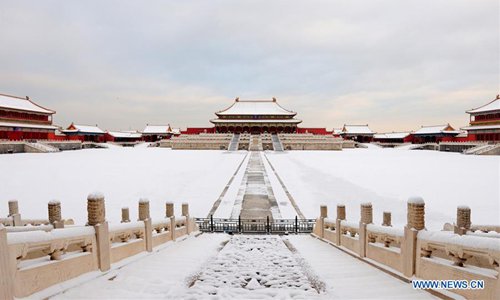Scenic sites, local cuisine and rich history: China’s capital has it all
Source:Global Times Published: 2019/12/16 19:13:41

This undated file photo shows view of the Palace Museum after snow in Beijing, capital of China. (Xinhua/The Palace Museum)
Winter in Beijing may be unfavorably cold to some, but that isn't a reason to leave the city. Otherwise, you'd be missing out on unique Forbidden City experiences. The following dining spots allow guests to enjoy local cuisine, accompanied by beautiful winter scenery.Peking duck at the palace
Compared to time-honored Peking duck restaurants such as Quanjude and Bianyifang, Siji Minfu, which was established in 2008, has grown increasingly popular in recent years. Its Forbidden City location is a standout among its other locations across the city as it is the perfect opportunity to combine the restaurant's heavenly dishes with a grand view of the former imperial palace.
Guests should prepare for relatively long wait times given its location in the heart of the city, and those who want a table with a view of the nearby 500-year-old UNESCO World Heritage site can expect to wait even longer. Rest assured, the wait is well worth it.
The windows provide a view of the Forbidden City, which also houses the Palace Museum, across the moat. When snow covers its golden-tiled roofs, the color of the magnificent purple walls stands out even more.
When a mouth-watering aroma shifts your attention, you'll find that the chef has brought a freshly roasted duck to your table. It is sliced in front of you, and the thin and crispy skin is separated from the meat.
It's served with spring onion, cucumber, radish, and sweet bean sauce. Wrap the ingredients with a piece of crispy skin or meat dipped in bean sauce. Take a bite, and savor the flavor as it spreads across your tongue.
Imperial cuisine at Beihai Park
Established in 1925 by Zhao Renzhai, a former chef worked in the Qing Dynasty (1644-1911) imperial kitchens, the Fangshan Restaurant specializes in imperial court cuisine. It is best known for manhan quanxi, which roughly translates into "complete feast of ethnic Manchu and Han dishes."
While the traditional manhan quanxi is intended to be consumed across four to six separate banquets, the select version at Fangshan Restaurant includes the essence of the dishes within one meal. Additionally, the restaurant is famous for its imperial pastry wandouhuang, a sweet pudding made with peas. It is said that the Empress Dowager Cixi of the Qing Dynasty was fond of this dessert.
As for the dining environment, the restaurant is located in Beihai Park.
First built during the 11th century, the park was one of the largest imperial gardens in China and is home to numerous historic sites. It was later opened to the public in 1925.
From Fangshan, you can see the White Pagoda, one of the most notable spots of Beihai Park across the frozen lake.
Over the years, many prominent Chinese political figures, including late Chinese leaders Zhou Enlai and Deng Xiaoping, hosted events at the Fangshan Restaurant.
Shandong cuisine at Shichahai
Not far from Beihai Park, is Qingyunlou, a historic restaurant specializing in cuisine from East China's Shandong Province.
First established in 1820, it was patronized by imperial families during the Qing Dynasty.
It was later closed during the 1920s and reopened at its original location in 2002. Fortunately, the traditions and cooking skills required to make traditional reputed dishes such as cujiaoyu (vinegar-and-pepper fish) at Qingyunlou have been passed down.
The restaurant has maintained some of its original structure and decor. A couplet hanging on the third floor is said to have been written by Chen Jichang, a Qing Dynasty scholar who was the last person in China to pass all three levels of the imperial exam - the xiangshi, huishi and dianshi.
Unlike the first two restaurants mentioned, Qingyunlou is in a hutong (narrow street alleys lined with traditional courtyard residences) neighborhood.
From the restaurant's windows, visitors can see traditional rooftops with grey tiles and courtyards. Depending on which table you are seated at, the nearby Drum and Bell Towers may also be seen.
Winter is usually cold and bleak, but it doesn't have to be when living in Beijing. During your stay, have some fun exploring the city's rich history and fine dining.
Newspaper headline: Winter in Beijing
Posted in: FOOD